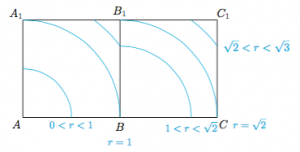(2013年海淀高三期末)已知正方体$ABCD-A_1B_1C_1D_1$的棱长为$1$,动点$P$在正方体$ABCD-A_1B_1C_1D_1$表面上运动,且$PA=r$($0<r<\sqrt 3$).记点$P$的轨迹的长度为$f(r)$.
(1) 求$f\left(\dfrac 12\right)$;
(2) 求出关于$r$的方程$f(r)=k$的解的个数的所有可能的值,并说明理由.

分析与解 由于正方体绕其体对角线旋转$120^\circ$后仍与自身重合,于是$f(r)$为点$P$在正方体的侧面$ABB_1A_1$与$BCC_1B_1$上的轨迹长度之和的$3$倍.将右侧面$BCC_1B_1$翻折至与侧面$ABB_1A_1$重合,如图.稍加探索可以发现$r=1$和$r=\sqrt 2$是两个分界点. (1) 当$0<r\leqslant 1$时,有$f(r)=\dfrac{3r\pi}2$,于是$f\left(\dfrac 12\right)=\dfrac{3\pi}4$.
(1) 当$0<r\leqslant 1$时,有$f(r)=\dfrac{3r\pi}2$,于是$f\left(\dfrac 12\right)=\dfrac{3\pi}4$.
(2) 当$\sqrt 2\leqslant r<\sqrt 3$时,图中弧的半径为$\sqrt{r^2-1}$,所对的圆心角为$\dfrac{\pi}2-2\arccos\dfrac{1}{\sqrt{r^2-1}}$,记$\theta=\arccos\dfrac{1}{\sqrt{r^2-1}}$,其中$\theta\in\left[0,\dfrac{\pi}4\right)$,则对应的弧长$$l(\theta)=\left(\dfrac{\pi}2-2\theta\right)\cdot \dfrac{1}{\cos\theta},$$其导函数$$l'(\theta)=\dfrac{-2-2\theta\tan\theta+\dfrac{\pi}2\tan\theta}{\cos\theta}<0,$$于是随着$r$的增大,$\theta$随之增大,对应的弧长随之减小,$f(r)$随之减小.
当$1<r<\sqrt 2$时,设$\theta=\arccos\dfrac{1}{r}$,其中$\theta\in\left(0,\dfrac{\pi}4\right)$,则弧长之和$$h(\theta)=\left(\dfrac{\pi}2-2\theta\right)\cdot\dfrac{1}{\cos\theta}+\dfrac{\pi}2\cdot\tan\theta=\dfrac{\pi}2\cdot\dfrac{\sin\theta-\dfrac 4{\pi}\theta+1}{\cos\theta},$$于是$$h'(\theta)=\dfrac{\pi}2\cdot \dfrac{1+\sin\theta-\dfrac{4}{\pi}\left(\cos\theta+\theta\cdot\sin\theta\right)}{\cos^2\theta},$$设$$\varphi(\theta)=1+\sin\theta-\dfrac{4}{\pi}\left(\cos\theta+\theta\cdot\sin\theta\right),$$则$\varphi(0)=1-\dfrac 4{\pi}<0$,$\varphi\left(\dfrac{\pi}4\right)=1-\dfrac{4}{\pi}\cdot \dfrac{\sqrt 2}2>0$,而$$\varphi'(\theta)=\cos\theta\cdot\left(1-\dfrac 4{\pi}\theta\right)>0,$$因此$\varphi(\theta)$在$\left(0,\dfrac{\pi}4\right)$上先负后正,对应的$h(\theta)$在$\left(0,\dfrac{\pi}4\right)$先递减再递增.
这样我们就可以勾勒出函数$f(r)$的图象如下. 于是方程$f(r)=k$的解的个数的所有可能值为$0,2,3,4$.
于是方程$f(r)=k$的解的个数的所有可能值为$0,2,3,4$.
注 本题是北京海淀区高三期末考试的一道填空题,为了严格地说清为什么解的个数有且只有这些很需要费一番功夫.
